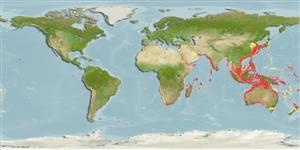Environment: milieu / climate zone / depth range / distribution range
Ökologie
seewasser demersal; tiefenbereich 10 - 200 m (Ref. 121768). Tropical; 36°N - 34°S, 24°E - 154°E
Indo-West Pacific: Algoa Bay, South Africa to southern Japan and Australia.
Length at first maturity / Size / Gewicht / Alter
Maturity: Lm 30.0 range ? - ? cm
Max length : 90.0 cm SL Männchen/unbestimmt; (Ref. 559)
Rückenflossenstacheln (insgesamt): 0; Rückenflossenweichstrahlen (insgesamt): 12-14; Afterflossenstacheln 0; Afterflossenweichstrahlen: 10 - 12. Dorsal part of body without prickles, belly covered with prickles (Ref. 559). Greenish or dark grey above, silvery white below (Ref. 4919). Distinguished from other Lagocephalus species by the black gill opening (Ref. 559).
Found in the shelf edge (Ref. 11230). Closely resembles the Atlantic species L. laevigatus Linnaeus which reaches southern Angola (Ref. 4919).
Life cycle and mating behavior
Geschlechtsreife | Fortpflanzung | Ablaichen | Eier | Fecundity | Larven
Smith, M.M. and P.C. Heemstra, 1986. Tetraodontidae. p. 894-903. In M.M. Smith and P.C. Heemstra (eds.) Smiths' sea fishes. Springer-Verlag, Berlin. (Ref. 4919)
IUCN Rote Liste Status (Ref. 130435)
Bedrohung für Menschen
Poisonous to eat (Ref. 559)
Nutzung durch Menschen
Mehr Information
ReferenzenAquakulturAquakultur ProfilZuchtlinienGenetikElectrophoresesVererbbarkeitKrankheitenVerarbeitungNutrientsMass conversion
PartnerBilderStamps, Coins Misc.LauteCiguateraGeschwindigkeitSchwimmstilKiemenoberflächeOtolithsGehirngrößeSehfähigkeit
Tools
Zusatzinformationen
Download XML
Internet Quellen
Estimates based on models
Preferred temperature (Ref.
123201): 16.6 - 28.3, mean 26.4 °C (based on 1313 cells).
Phylogenetic diversity index (Ref.
82804): PD
50 = 0.5005 [Uniqueness, from 0.5 = low to 2.0 = high].
Bayesian length-weight: a=0.02692 (0.01730 - 0.04187), b=2.86 (2.74 - 2.98), in cm total length, based on LWR estimates for this species & Genus-body shape (Ref.
93245).
Trophic level (Ref.
69278): 3.9 ±0.4 se; based on size and trophs of closest relatives
Generation time: 2.1 ( na - na) years. Estimated as median ln(3)/K based on 1
growth studies.
Widerstandsfähigkeit (Ref.
120179): niedrig, Verdopplung der Population dauert 4,5 - 14 Jahre. (K=0.53).
Fishing Vulnerability (Ref.
59153): Moderate vulnerability (36 of 100).
